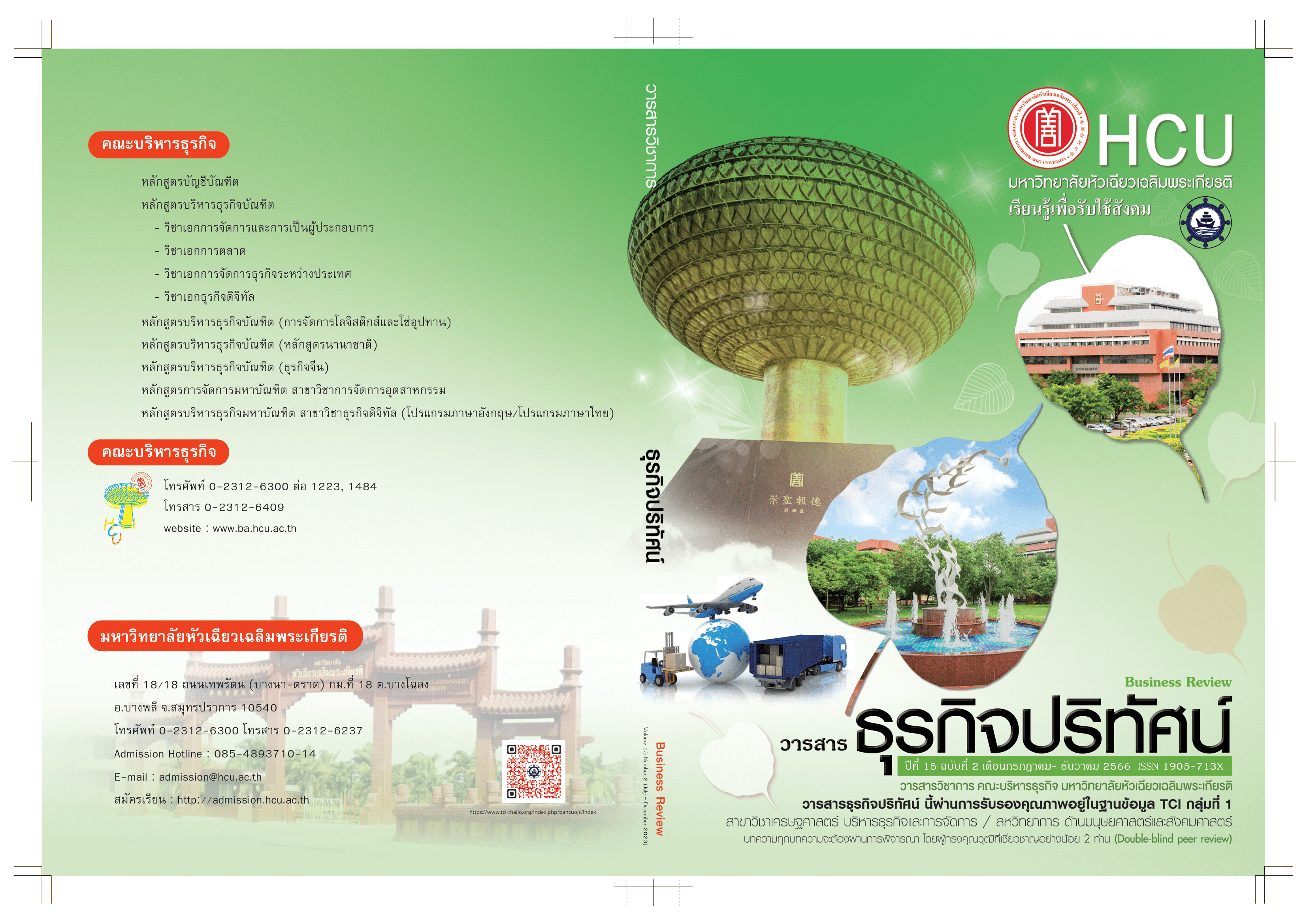การศึกษาแบบจำลองเชิงสาเหตุของการจัดการโลจิสติกส์ท่องเที่ยวที่มีอิทธิพลต่อความจงรักภักดีของนักท่องเที่ยวในกลุ่มจังหวัดภาคใต้ฝั่งอันดามัน
คำสำคัญ:
การจัดการโลจิสติกส์ท่องเที่ยว , ความไว้วางใจ, ความพึงพอใจของนักท่องเที่ยว , ความจงรักภักดีบทคัดย่อ
การศึกษาแบบจำลองเชิงสาเหตุของการจัดการโลจิสติกส์ท่องเที่ยวที่มีอิทธิพลต่อความจงรักภักดีของนักท่องเที่ยวในกลุ่มจังหวัดภาคใต้ฝั่งอันดามัน มีวัตถุประสงค์คือ 1) เพื่อตรวจสอบความสอดคล้องของรูปแบบจำลองเชิงสาเหตุของตัวแปรที่มีอิทธิพลต่อความจงรักภักดีของนักท่องเที่ยวในกลุ่มจังหวัดภาคใต้ฝั่งอันดามันที่พัฒนาขึ้นกับข้อมูลเชิงประจักษ์ 2) เพื่อศึกษาอิทธิพลทางตรง อิทธิพลทางอ้อมและอิทธิพลรวมของตัวแปรต่อความจงรักภักดีของนักท่องเที่ยวและ 3) เพื่อพัฒนารูปแบบจำลองเชิงสาเหตุของตัวแปรที่มีอิทธิพลต่อความจงรักภักดีของนักท่องเที่ยวในกลุ่มจังหวัดภาคใต้ฝั่งอันดามัน โดยใช้ระเบียบวิจัยเชิงปริมาณ โดยใช้แบบสอบถามเป็นเครื่องมือเก็บข้อมูลจากนักท่องเที่ยวในกลุ่มจังหวัดภาคใต้ฝั่งอันดามัน จำนวน 240 ชุด และวิเคราะห์ด้วยค่าสถิติเชิงพรรณนาและรวบรวมข้อมูลมาวิเคราะห์โดยใช้การวิเคราะห์ค่าทางสถิติและรูปแบบสมการโครงสร้าง (Structural Equation Model : SEM) ผลการวิจัยพบว่า ความไว้วางใจ การจัดการโลจิสติกส์ท่องเที่ยว และความพึงพอใจของนักท่องเที่ยวมีอิทธิพลต่อความจงรักภักดีของนักท่องเที่ยว โดยความจงรักภักดีของนักท่องเที่ยวได้รับผลกระทบเชิงบวกจากการจัดการโลจิสติกส์ท่องเที่ยว พร้อมกับได้รับผลกระทบเชิงบวกจากความไว้วางใจและความพึงพอใจของนักท่องเที่ยวอย่างมีนัยสำคัญทางสถิติ ดังนั้นภาครัฐและภาคเอกชนควรร่วมมือกันเพื่อจัดการโครงสร้างพื้นฐานตลอดโซ่อุปทานการท่องเที่ยว ด้วยการคำนึงถึงการจัดการโลจิสติกส์ที่เหมาะสมจะสามารถส่งผลกระทบต่อความน่าเชื่อถือ ความปลอดภัย และสร้างความพึงพอใจให้กับนักท่องเที่ยวทำให้นักท่องเที่ยวมีการแนะนำบอกต่อและกลับมาเที่ยวซ้ำ
เอกสารอ้างอิง
กนก บุญศักดิ์ และคณะ. (2561). อิทธิพลของปัจจัยที่มีต่อความภักดีของนักท่องเที่ยวต่อการท่องเที่ยวบนฐานชุมชนภาคตะวันออกเฉียงเหนือตอนล่างของประเทศไทย. วารสารชุมชนวิจัย, 12(1), 11-27.
กระทรวงการท่องเที่ยวและกีฬา. (2562). สถิตินักท่องเที่ยวภายในประเทศ (จำแนกตามภูมิภาคและจังหวัด). สืบค้นเมื่อ 28 กุมภาพันธ์ 2563, เว็บไซต์: https://www.mots.go.th/old/more_news.php?cid=525&filename=index
เถกิงศักดิ์ ชัยชาญ. (2555). การจัดการโลจิสติกส์สำหรับการท่องเที่ยวในอำเภอวังน้ำเขียว จังหวัดนครราชสีมา. วารสารเทคโนโลยีสุรนารี, 6(2), 17-33.
มิ่งสรรพ์ ขาวสะอาด และคณะ. (2556). เศรษฐศาสตร์ว่าด้วยการท่องเที่ยว Tourism Economics. เชียงใหม่.สถาบันวิจัยสังคม มหาวิทยาลัยเชียงใหม่, 1(1), 1-222.
สำนักบริหารยุทธศาสตร์กลุ่มจังหวัดภาคใต้ฝั่งอันดามัน. (2561). แผนพัฒนากลุ่มจังหวัดภาคใต้ฝั่งอันดามัน 2561-2564. สืบค้นเมื่อ 28 กุมภาพันธ์ 2563, เว็บไซต์: https://www.trang.psu.ac.th/planform/6-2.pdf
Belanche, D., Casaló, L. V., & Flavián, C. (2010). Providing online public services successfully: the role of confirmation of citizens’ expectations. International Review on Public and Nonprofit Marketing, 7(2), 167-184.
Best, J. W., & Kahn, J. V. (1998). Research in education. 8th ed. Boston: Allyn and Bacon.
Bilgihan, A. (2016). Gen Y customer loyalty in online shopping: An integrated model of trust, user experience and branding. Computers in Human Behavior, 61, 103-113.
Calvo-Porral, C., & Lévy-Mangin, J. P. (2017). Store brands’ purchase intention: Examining the role of perceived quality. European Research on Management and Business Economics, 23(2), 90-95.
Chaudhuri, A., & Holbrook, M. B. (2001). The chain of effects from brand trust and brand affect to brand performance: the role of brand loyalty. Journal of marketing, 65(2), 81-93.
Chen, C. F., & Tsai, D. (2007). How destination image and evaluative factors affect behavioral intentions? Tourism management, 28(4), 1115-1122.
Cronbach, L. J. (1990). Essentials of Psychological Testing. New York: Harper & Brothers.
Dedeoğlu, B. B. (2019). Shaping tourists' destination quality perception and loyalty through destination country image: The importance of involvement and perceived value. Tourism Management Perspectives, 29, 105-117.
Gursoy, D., McCleary, K. W., & Lepsito, L. R. (2007). Propensity to complain: Effects of personality and behavioral factors. Journal of Hospitality & Tourism Research, 31(3), 358-386.
Han, H., & Hyun, S. S. (2015). Customer retention in the medical tourism industry: Impact of quality, satisfaction, trust, and price reasonableness. Tourism Management, 46, 20-29.
Hair, J. F., Black, W. C., Babin, B. J., & Anderson, R. E. (2010). Multivariate data analysis (7th ed.). New Jersey, USA: Prentice Hall.
Lauro, C., & Vinzi, V. E. (2004). Some contributions to PLS Path Modeling and a system for the European Customer Satisfaction. Journal of Applied Statistics, 26, 201-210.
Jani, D., & Han, H. (2014). Personality, satisfaction, image, ambience, and loyalty: Testing their relationships in the hotel industry. International Journal of Hospitality Management, 37, 11-20.
Jin, Z., Dai, K., Fu, G., & Li, Y. (2017). Discussion on tourism logistics based on the separation and combination of tourists and items theory. American Journal of Industrial and Business Management, 7(4), 537-547.
Jöreskog, K. G., & Sörbom, D. (1989). LISREL 7: A guide to the program and applications. Chicago: SPSS International.
Kannika, M. (2019). The Development of Tourism Geographic Information System in Respond to Demand Behavior of Thai tourists: The case Study of Chachoengsao Province. Journal of Rajanagarindra University, 15(12), 34-42.
Kanwel, S., Lingqiang, Z., Asif, M., Hwang, J., Hussain, A., & Jameel, A. (2019). The Influence of Destination Image on Tourist Loyalty and Intention to Visit: Testing a Multiple Mediation Approach. Sustainability, 11(22), 6401.
Kwok, S. Y., Jusoh, A., & Khalifah, Z. (2016). The influence of service quality on satisfaction: Does gender really matter?. In Guo ible capital, 12(2), 444-461.
Liang, C. J., & Wang, W. H. (2007). An insight into the impact of a retailer's relationship efforts on customers' attitudes and behavioral intentions. International Journal of Bank Marketing, 25(5), 336-366
Liang, D., Ma, Z., & Qi, L. (2013). Service quality and customer switching behavior in China's mobile phone service sector. Journal of Business Research, 66(8), 1161-1167.
Likert, S. (1972). Likert technique for attitude measurement. Social Psychology, 1(2), 101-119.
Lomax, R. G., & Schumacker, R. E. (2012). A beginner's guide to structural equation modeling. New York: Routledge Academic.
Lumsdon, L., & Page, S. J. (2004). Progress in transport and tourism research: reformulating the transport-tourism interface and future research agendas. Tourism and Transport, 1(7), 16-43.
Osman, Z., & Sentosa, I. (2013). A study of mediating effect of trust on customer satisfaction and customer loyalty relationship in Malaysian rural tourism. European Journal of Tourism Research, 6(2), 192-206.
Sae–here, Rossukhon. (2015). Customer Behaviors of Using Hotel’s Service, Service Marketing Mix and Brand Equity Affecting Foreign Customer Satisfaction toward Hotel’s Service: A Case Study of the Five – Star Hotel in Bangkok. Master’s Thesis in Business
Administration, Graduation School, Bangkok University.
Sirakaya-Turk, E., Ekinci, Y., & Martin, D. (2015). The efficacy of shopping value in predicting destination loyalty. Journal of Business Research, 68(9), 1878-1885.
Su, L., Hsu, M. K., & Swanson, S. (2017). The effect of tourist relationship perception on destination loyalty at a world heritage site in China: The mediating role of overall destination satisfaction and trust. Journal of Hospitality & Tourism Research, 41(2), 180-210.
Tasci, A. D. (2016). A critical review of consumer value and its complex relationships in the consumer-based brand equity network. Journal of Destination Marketing & Management, 5(3), 171-191.
Tsai, C. F. (2015). The Relationships among Destination Image, Perceived Quality, Emotional Place Attachment, Tourist Satisfaction, and Post-visiting Behavior Intentions. Marketing Review/Xing Xiao Ping Lun, 12(4), 455-479.
Van Lierop, D., & El-Geneidy, A. (2016). Enjoying loyalty: The relationship between service quality, customer satisfaction, and behavioral intentions in public transit. Research in Transportation Economics, 59, 50-59.
Wang, C., & Teo, T. S. (2020). Perceived Value and Continuance Intention in Mobile Government Service in China. Telematics and Informatics, 48, 101348.
World Tourism Organization (UNWTO). (2019). International tourism continues to outpace the global economy. Retrieved February 28, 2020, Website: https://www.unwto.org/publication/international-tourism-highlights-2019-edition
ดาวน์โหลด
เผยแพร่แล้ว
รูปแบบการอ้างอิง
ฉบับ
ประเภทบทความ
สัญญาอนุญาต
ลิขสิทธิ์ (c) 2023 วารสารธุรกิจปริทัศน์

อนุญาตภายใต้เงื่อนไข Creative Commons Attribution-NonCommercial-NoDerivatives 4.0 International License.
บทความที่ได้รับการตีพิมพ์จะเป็นลิขสิทธิ์ของวารสารธุรกิจปริทัศน์
ข้อความที่ปรากฏในบทความแต่ละเรื่องในวารสารวิชาการเล่มนี้เป็นความคิดเห็นส่วนตัวของผู้เขียนแต่ละท่านไม่เกี่ยวข้องกับมหาวิทยาลัยหัวเฉียวเฉลิมพระเกียรติ และคณาจารย์ท่านอื่น ๆ ในมหาวิทยาลัยฯ แต่อย่างใด ความรับผิดชอบองค์ประกอบทั้งหมดของบทความแต่ละเรื่องเป็นของผู้เขียนแต่ละท่าน หากมีความผิดพลาดใด ๆ ผู้เขียนแต่ละท่านจะรับผิดชอบบทความของตนเองแต่ผู้เดียว





